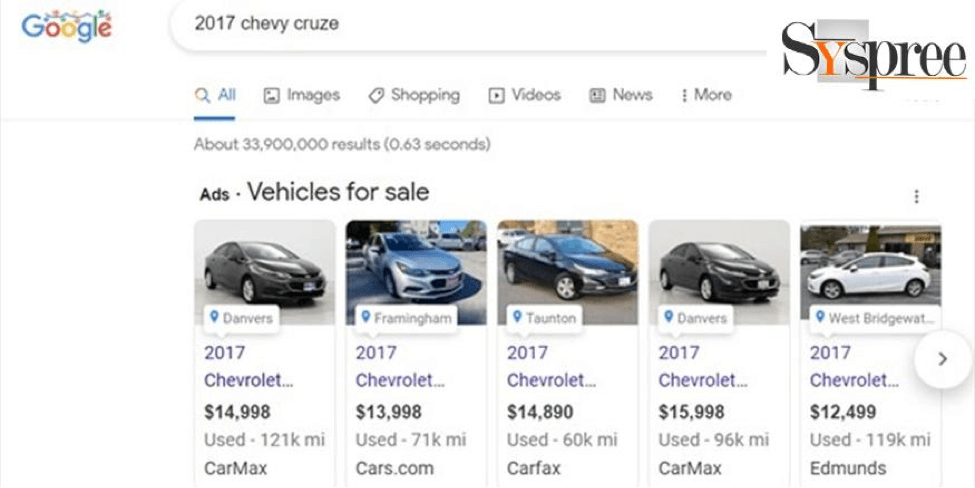To transform how car dealerships display their stock, Google has unveiled a revolutionary solution – Structured Data Markup. This cutting-edge tool makes it easier to manage the process of showing vehicle inventory and makes it easier and more effective for dealers of any size. The main goal? To provide potential buyers with an effortless and informative experience when searching.
Key Takeaways
- Google’s Structured Data Markup revolutionizes how dealers present their inventory, resulting in a seamless searching experience for prospective buyers.
- Structured Data for car dealership inventory streamlines the display of vehicle inventory by making it easy to organize and accessible for dealerships of all sizes.
- Structured data for vehicle listings for Google Search, Maps, and Business Profiles enhances the shopping experience for dealers and customers.
- The app’s availability for users in English and cross-device access guarantees accessibility.
- Dealers can simplify their inventory listings using Structured Data Markup or Data Feeds. Each has its advantages; however, data alignment is essential to success.
Google’s New Structured Data for Car Dealership Inventory
Google’s Structured Data Markup, tailored specifically to the inventory of car dealerships, can be a game-changer. It allows dealers to easily display their available vehicles through Google Search, Maps, and Business Profiles.
The leading SEO company in Mumbai says that it gives potential buyers a comprehensive overview of the available models, with crucial information such as prices, features, availability, and more. This latest convenience is accessible in English throughout the United States, accessible both via mobile and desktop platforms.
Enhanced Method for Car Dealerships

Structured Data for Car Dealership Inventory – Enhanced Method for Car Dealerships
What exactly is this improved structured data method function? It involves making markups in the HTML code of websites for dealerships to provide complete information on their inventory of vehicles.
This is a major contrast to Google’s prior method, which often required dealerships to upload data feeds manually. By using structured information, dealers can easily integrate descriptions of car prices, availability and other vital information into their existing car listings.
This unique option is useful for dealers who cannot comprehend the complexities of data feeds, which are overwhelming or haven’t yet submitted their inventory information to Google.
It’s crucial to remember that feeds are still a viable alternative for those who prefer the latter. Both options have advantages; however, to avoid any inconsistencies, the information contained in feeds and the markups must match.
Benefits of Structured Data Markup for Car Dealerships
In the ever-changing digital landscape, car dealerships are constantly searching for new ways to ease the process of advertising their inventory of vehicles. Take a look at structured data for car dealership inventory A powerful tool that has numerous advantages that make it simpler than ever for dealers to connect with prospective buyers and give them the data they require.
Simplifying Vehicle Inventory Display
The experts from the leading SEO company in Mumbai say that one of the main benefits of structured data markup is its capacity to make it easier to display the inventory of cars. By incorporating structured data on their websites, dealerships can offer a more efficient and consistent display of their cars available.
It allows potential buyers to quickly and effortlessly access important details like prices, details, features, and availability. Buyers can easily navigate through messy or difficult-to-navigate listings. Thanks to the structured markup of data, data is organized neatly and easily accessible.
Accessibility for Dealerships
The improved accessibility provided through structured data for car dealership inventory is a game changer for dealers regardless of size. In the past, dealers had difficulty understanding the complexities of data feed files or other ways of displaying inventory. Structured data is an easier way to do this.
By adding markup directly to the HTML website’s code, dealers can easily provide accurate and up-to-date information regarding their inventory of vehicles. This technique makes the process easier, reduces the chance of error, and ensures prospective buyers get the most up-to-date and accurate information about the cars they’re looking at.
Vehicle Listing Structured Data: Elevating the Car Shopping Experience

Structured Data for Car Dealership Inventory – Vehicle Listing Structured Data
There is a lot of competition in automobile retail, and customers have many options when purchasing cars. To be noticed in this competitive market, dealers must provide prospective buyers with an easy and comprehensive search experience. Google is aware of this and has launched Vehicle Listing Structured Data, an innovative solution expected to revolutionize how cars are presented and viewed online.
The best SEO company says that Vehicle Listing Structured Data was created to help car dealers, allowing them to showcase what they offer through Google Search, Maps, and Business Profiles. This feature will benefit everyone, both the dealership and potential buyers.
Displaying Inventory on Google Search, Maps, and Business Profiles
It provides a simple way for car dealers to display their available inventory. By incorporating structured data markups on their websites, dealerships can make sure that their cars are not just available to prospective buyers but are also presented logically and structured.
This method reduces time and the need for dealers to work with complicated data feeds and other cumbersome processes. It simplifies the process and reduces the chance of making mistakes, resulting in the most efficient way to connect with customers.
Enhanced Search Experience for Buyers
However, for potential buyers, this technology will provide an improved search experience. If they use Google to find cars that are available it is now possible to filter and find out about the cars available for sale quickly and easily.
The experts from the best SEO company say that this data is structured to allow prospective buyers to get the most important information about the vehicle, like price, features, and availability in their search results. This eliminates the need to browse multiple websites or delve into listings to find the required data. This improved convenience simplifies searching to make it quicker and easier for users.
Availability and Language Support for Vehicle Listing Structured Data
In the constantly expanding world of digital marketing, accessibility and support for languages are vital to any innovative tool. With Google’s Vehicle Listing Structured Data, these elements are important to ensure that potential and future buyers can benefit from this feature without obstacles.
Feature Availability in English
Since its launch, Vehicle Listing Structured Data has been accessible in English and is accessible to a large population across the United States. Even though English is a well-known language, this initial offer opens the door to greater accessibility.
The leading digital marketing company says that Google has a history of expanding its capabilities in terms of language for its services and services. Therefore, the structured data for car dealership inventory will soon be available in several languages. This accessibility makes it much easier for dealers and customers with different backgrounds to reap these benefits from this new feature.
Access on Mobile and Desktop
Additionally, accessibility isn’t restricted to just one language and extends to the devices that use this tool. Google guarantees that Vehicle Listing Structured Data can be accessed via desktop and mobile devices. In a time when mobile devices generate most internet traffic, cross-platform accessibility is essential. It lets users access structured data, browse the listings of cars, and collect information on available vehicles. At the same time, they travel using their mobile devices or by using their desktop PC.
This cross-device support confirms Google’s intention to provide a seamless experience for all users regardless of the preferred internet connection method. It doesn’t matter if you’re a dealer looking to display your inventory or a prospective buyer searching for the perfect car; you can easily do it on the device you prefer.
Streamlining Dealership Listings with Structured Data Markup

Structured Data for Car Dealership Inventory – Streamlining Dealership Listings with Structured Data Markup
In today’s frantic market, car sales efficiency is paramount, and providing prospective buyers with up-to-date, comprehensive details about the available cars is an absolute priority for dealers. Google’s Structured Data Markup comes as fresh air, transforming how listings from dealerships are handled and displayed. Through streamlining processes for integrating car data, this revolutionary technology is changing the game.
Integrating Vehicle Information
Introduced Structured Data for car dealership inventory gives car dealerships an easy and effective display method. Instead of relying upon complex data feeds or other complicated methods, dealerships can now incorporate structured data directly into the HTML code on their websites.
This process simplifies the integration of car information and makes it easier for users to find it. Dealerships can effortlessly integrate descriptions of vehicle prices, availability, and other important information into their current car listing pages and ensure that the information is consistent and precise.
Comparison with Data Feed Files
This strategy offers car dealers an edge in competition. It reduces the requirement for expertise in technology and large development, which makes it accessible to dealers of any size. By using structured data markups, dealers can give potential buyers organized and clear information about their car inventory, resulting in a simpler experience for buyers.
Compared to traditional feeds, structured data markup provides significant improvements in terms of efficiency. Although feed files are effective, they typically require more work to develop and could take longer for Google to recognize updates. However, structured data markup can simplify the process and provide dealers with the fastest and most straightforward solution. It makes sure that the data is easily accessible and precise, which reduces the chance of differences.
Two Methods of Providing Inventory Data: Structured Data Markup vs. Data Feeds
In the realm of managing inventory at car dealerships, data is the king. The accuracy and speed of data are vital to provide prospective buyers with the data they require. Google’s unique approach to this problem provides two different methods for dealers to share their inventory information – the Structured Data Markup or Data Feeds. Each offers its advantages and is suitable for various needs, addressing the diverse needs of dealerships.
Structured Data Markup vs. Data Feeds
Structured Data Markup can revolutionize the way inventory data from vehicles is displayed. Dealers incorporate structured data directly into their HTML web pages through this method. This makes it easier for users by allowing dealerships to easily include important information, including price, vehicle description and availability, to their existing listing of cars pages.
The markup for Structured Data Markup is ideal for dealers who require an easy way to provide information to Google. It is particularly useful for dealers of any size, offering a user-friendly approach that does away with the need for complicated feeds of data.
Benefits and Suitability
On the other hand, Data Feeds offer a traditional way of supplying inventory information. Dealerships upload data feeds to Google’s car listings partner portal. While this process might require more effort for the development of the system, however, it has distinct advantages.
Data feed uploads ensure that Google consistently receives all inventory data without delay. This is especially advantageous for larger dealerships or those with complex data management systems because it permits a more thorough and organized approach to data distribution.
The decision of Structured Data Markup and Data Feeds will ultimately depend on a dealer’s particular requirements and resources. Structured Data Markup is easy to use and accessible, as data Feeds are an extensive and comprehensive method.
Some dealerships choose to use both methods to improve their data and reach accuracy. No matter which method they choose, the most important thing is to ensure that the data in both feeds and markups are in line to avoid any inconsistent data.
Ensuring Data Consistency: Matching Data in Feeds and Markup

Structured Data for Car Dealership Inventory – Ensuring Data Consistency
In inventory management for car dealerships, the need to ensure data consistency is essential. Ensure potential buyers have current and accurate data to establish confidence and enable smooth transactions.
Google’s launch of Structured Data Markup and Data Feeds provides dealerships with various options to show their inventory of vehicles. To ensure data accuracy and avoid inconsistencies, it’s essential to ensure that the information contained in both feeds and markups is consistent and flawless.
Matching Data in Feeds and Markups
Making sure that feeds match and markups serve two important goals. First, it ensures that the information provided to prospective buyers is unbiased. If feeds and markups are in sync, this reduces the possibility of contradicting information that could confuse potential buyers and negatively impact the credibility of a dealership. Congruity builds trust, which is an essential aspect of car buying.
Second, Google’s algorithms need to recognize and categorize inventory information. Google utilizes this information to create search results and provide its users with precise and pertinent data. If the feeds’ data and markup are in sync and are consistent, it can cause variations in search results, which could cause vehicles to be excluded or classified incorrectly.
Avoiding Inconsistencies
The experts from the leading digital marketing company say that to ensure data consistency, dealers must implement a systematic approach to data consistency. This requires regular checks and cross-referencing between data in their feeds and the structured data markup. Any discrepancies should be quickly rectified to ensure that data provided to prospective buyers is up to date.
Automation of this procedure is a further successful strategy. With the help of automatized checks and verification procedures, dealerships can decrease the risk of human error while maintaining the accuracy of the data more easily.
Conclusion
Google’s structured data for car dealership inventory and Data Feeds offer car dealerships numerous options for managing inventory. Structured Data streamlines the process, and Data Feeds guarantee complete information. Affiliating data from both markup and feeds is essential for trust and consistency. The decision is based on the dealership’s requirements, but aligning data is crucial to success. If you like this blog check out our previous blog Google’s Blocks Third-Party Cookies for 1% of its Chrome Users in 2024.








Very informative blog . Liked this blog a lot. Thank you for sharing.
We’re thrilled to hear that you found our blog informative and that you liked it! Thank you for your kind words and for taking the time to share your feedback.
this is a good option launched by google.
We appreciate your positive feedback!
This is great news for the car dealership industry! Your blog post was very informative and provided valuable insights. Keep up the great work
Thank you so much for your positive feedback! We’re delighted to hear that you found our blog post informative and valuable